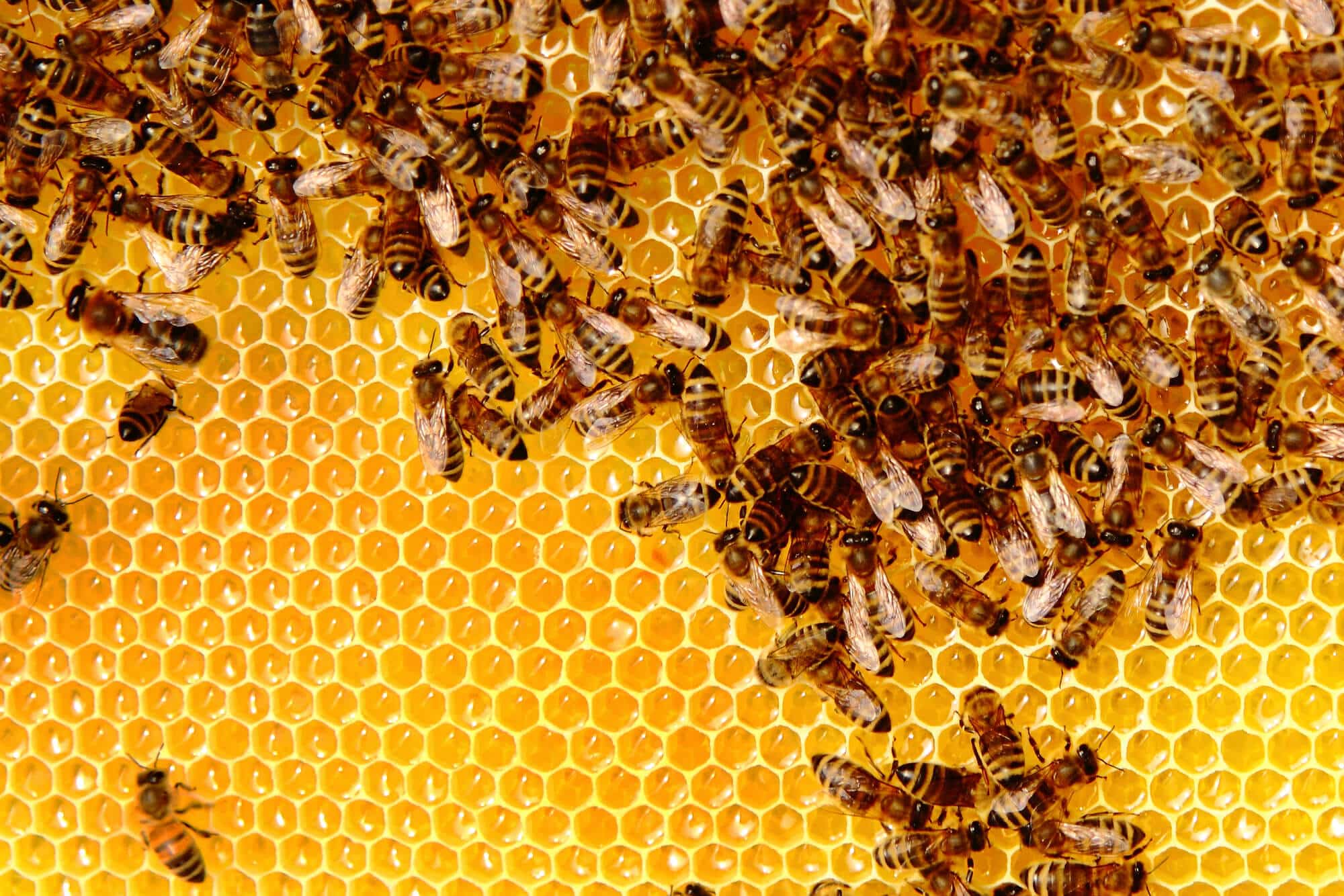The power of a group - the electrifying version: British researchers discovered that swarms of bees carry a particularly powerful electrical charge. It turns out that the buzz is literal
By Nina Sodin, Angle - Science and Environment News Agency

Last September, amid the flood of articles that flooded the world after the death of the Queen of Great Britain, Elizabeth II, one piece of news might have seemed particularly puzzling: the royal beekeeper He said to the bees in the hives the royalty that the Queen has passed away, and that King Charles III is their new owner.
No, the beekeeper (beekeeper) did not go out of his mind because of the pain of losing his queen: the origin of this gesture is in an ancient British tradition, according to which the bees should be informed of important human events, such as death or marriage. According to tradition, if they are not given significant information like this - they may stop producing honey and even leave the hive.
So for now there is no scientific proof that the bees are indeed affected by our daily news, but it is known that these wonderful creatures have a variety of other abilities: bees Calling this עם this through Dance, building beehives Effectively Out wall, And even "Conversing" עם flowers for the purpose of finding a feed. recently Was discovered More attribute Impressive Theirs, which is added to the long list: British researchers have discovered that the electrical charge that bee swarms carry is unusually powerful. How powerful? It turns out that it is stronger than the effect of meteorological phenomena, such as storm clouds, whose electrical voltage between them and the ground may create lightning.
The new research is further proof of the power of the small creatures, on which a large part of our food depends. Therefore, their existence is in danger as part harmful crisis the climate - She is very worrying. So what is the connection between bees and electricity, why do they fly in huge swarms in the first place, and why is all this important to us?
Electric bees?
Let's start from the basics: bees carry an electric charge. Weird, isn't it? The scientific explanation for this phenomenon is that the small creatures, like air, and like storms - carry molecules that have more electrons (particles with a negative electrical charge) than protons (particles with a positive electrical charge), or vice versa.
"When bees fly, they encounter electrically charged molecules, and thus charge themselves," explains Prof. Yoav Yair, dean of the School of Sustainability at Reichman University and an atmosphere and space researcher. In addition, the rapid flapping of their wings - over 200 flaps per second - may also cause the movement of electrons between molecules, thus creating a change in their electrical charge (similar to creating static electricity by rubbing with a balloon).
However, the strength of this charge was unknown until now. This figure was discovered completely by accident recently, when British researchers monitored the weather in the area of the University of Bristol in southwest England - and detected an unexpected increase in the electric field (a space created near electric charges, in which an electric force is applied to each additional charge that enters it) in the atmosphere around them.
While there were no storms in the area that could cause these changes, when the researchers checked their surroundings they discovered a swarm of honey bees, and decided to test what seemed like a coincidence: they monitored the electric field in the area using dedicated detectors, combined with video cameras designed to monitor the density of the swarm. "After they measured the strength of the field and the number of bees in the swarm, the researchers calculated the charge density - that is, the amount of electric charge per unit volume of the bee swarms," explains Yair.
Bees are very electrifying
According to Yair, when the weather is balanced, without special natural phenomena, we can measure in the air an electric field with a strength of about 130 volts per meter, which is created between the ionosphere - a layer of the atmosphere that has a positive charge, and the Earth - which has a negative charge.
In the new study, the researchers found that the bees created an electric field in the range of 1,000-100 volts per meter. That is, when the electric field they created was the most powerful, it was almost 8 times stronger than the normal electric field that exists in the air without the bees. It was also found that the denser the swarm was, the stronger the field it created.
"The researchers discovered that the density of the electric charge of the bees is higher than that of meteorological phenomena (weather events - NAS) that create a powerful electric field, such as a cloud in the middle of a thunderstorm or a cloud of sand created in a storm," says Yair. Following this, the researchers hypothesized that the electric field created by the bee swarms may even affect the weather; For example, causing clouds or hastening their transformation into rain.
Dancing all the way home
So, swarms of bees have an electric charge, and it is very powerful. But why in the first place do the bees fly in these huge swarms, which include thousands of individuals? "When the conditions in the hive are good, it may become too crowded due to the abundance of bees", explains Prof. Sharon Shapir, director of the Center for Bee Research and the Institute of Environmental Sciences at the Faculty of Agriculture, Food and Environment of the Hebrew University. "At this stage, the old queen leaves the nest together with about 10-6 bees, and about 20-10 bees remain behind and will raise a new queen."
The bees that have left with the queen fly together like a cloud, until they settle temporarily on a tree; From there they go looking for a new home, in a process that may be even more complex than looking for an apartment in Tel Aviv. "They have a long list of criteria," Shapir explains. "The place should be protected from madmen, high enough so that it will not be flooded by floods, appropriate in size and temperature and sufficiently isolated from the outside environment."
Each bee that finds a suitable place, returns to the swarm and dances a dance through which it conveys to the other bees information about the house in question. This "dance festival", which is actually a kind of democratic vote, continues until this community reaches a state of widespread agreement. So, the bees fly again, as one swarm, to their chosen abode. According to Shapir, in such cases, contrary to other motives that take them out of the hive, such as protecting it and the honey - they do fly in much larger swarms than usual, but they are harmless and do not sting.
How many locusts will it rain?

The new research opens a window to studies that have not been done before: examining the way in which living beings may affect their environment, in the electrical aspect. According to Shapir, until today in scientific research it was customary to examine mainly the effects of non-living factors (such as water, light or temperature) and electricity, on meteorological phenomena.
"When there are many electrically charged particles in the air that create a strong electric field, under the right meteorological conditions and the right humidity - a situation may arise that affects various weather phenomena," explains Yair. "For example, the charged particles can cause water to condense faster, because they attract water molecules to them - and thus cause clouds or fog to form faster, accelerate the transformation of clouds into rain or cause lightning to appear."
However, Yair wishes to clarify that the bee swarms are a local and relatively small phenomenon; Therefore, their effect will also be significant only if a particularly high concentration of them is created in a certain area. But this does not mean that the electric charge of other insects cannot have a substantial effect. Based on the measurements made on the bees, the researchers also estimated the charge density of large locust swarms, and found that it too can be very high. So are we going to witness "locust strikes" that will bring with them changes in the weather? "Locust swarms can include millions of insects, and spread over an area the size of entire countries; Moreover, with the climate crisis we see that the frequency of these swarms is increasing", Yair explains. "Therefore, it can be assumed that if the locust carries an electric charge - this could have an effect on the formation of fog, clouds and rain."
According to Yair, an extensive study of the phenomenon is needed. "This is a new subject, and only through research in the laboratory and in nature will we be able to find out whether the effect of insect swarms on meteorological phenomena is indeed possible," he concludes.
More of the topic in Hayadan:
